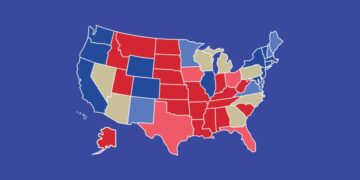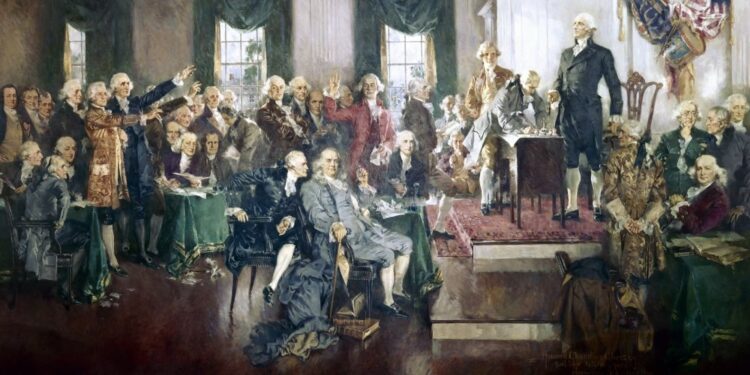The United States Constitution, adopted in 1787, is one of the shortest and oldest written constitutions in the world. Yet despite its brevity, it has endured for more than two centuries with remarkably few changes. As of today, only twenty-seven amendments have been successfully ratified, ten of which – the Bill of Rights – were adopted simultaneously in 1791.
In other words, in more than 230 years, only seventeen substantive amendments have been added. This rarity of change raises an important question: Why is the U.S. constitution so hard to amend? The answer lies in a complex interplay of historical intent, institutional design, procedural hurdles, political polarization, cultural reverence, and federalism.
1. The framers’ intent
The difficulty of amending the constitution is not accidental – it reflects a deliberate choice by the framers. They were reacting against two perceived dangers:
- Excessive rigidity, exemplified by the Articles of Confederation, which required unanimous consent of all thirteen states for amendments. This made reform nearly impossible and left the national government weak and ineffective.
- Excessive flexibility, which the Framers associated with pure democracy, where fleeting majorities could make drastic legal changes. Having studied classical history, they feared “tyranny of the majority” as much as monarchy.
Their solution was Article V, a mechanism that allowed for constitutional change but made the process intentionally arduous. Amendments were to be possible – but only when there was overwhelming national consensus.
2. The mechanics of Article V
Article V of the constitution outlines two paths for proposing amendments and two paths for ratifying them:
| Stage | Method 1 | Method 2 |
| Proposal | 2/3 of both Houses of Congress | 2/3 of State Legislatures call a Constitutional Convention |
| Ratification | 3/4 of State Legislatures | 3/4 of State Conventions |
While this structure appears open and balanced, in practice, it is extraordinarily difficult to meet these thresholds.
- The proposal stage requires supermajorities, meaning 67 Senators and 290 Representatives must agree. In today’s polarized political environment, even simple legislation struggles to clear basic majority votes.
- The ratification stage requires 38 out of 50 states to approve an amendment. Considering the vast ideological differences between states – from California to Alabama to Vermont – reaching such a national consensus is tremendously challenging.
Furthermore, the constitution provides no timeline or uniform procedure unless Congress specifies one. This ambiguity has led to legal disputes, such as in the case of the Equal Rights Amendment (ERA), where states later tried to rescind their ratifications.
3. Federalism and the influence of small states
Another key reason amendments are so hard to pass is the enormous power Article V gives to smaller states. Because each state – regardless of population – has one vote in ratification, states with tiny populations hold disproportionate influence. For example:
- Wyoming, with fewer than 600,000 residents, has equal ratification power to California, which has over 39 million.
- It would take 13 of the smallest states, representing less than 10% of the population, to block any amendment.
This bias towards small states is even more entrenched because Article V protects the equal suffrage of states in the senate from amendment itself. In other words, the constitution makes it constitutionally impossible to reduce the senate’s disproportionality without unanimous consent.
4. Partisan polarization and political incentives
In the early years of the republic, amendments were more common. The first twelve amendments were proposed and ratified within the first 15 years. However, over time, American politics became more partisan, and party competition hardened. Today, constitutional amendments are not just legal proposals – they are political weapons. Each party fears that constitutional change may benefit the other side, which leads to strategic obstruction. Consider the following examples:
- Voting rights, campaign finance reform, term limits, abortion, and gun control are all areas where activists have proposed amendments. Yet none gain traction because they are instantly aligned with partisan lines.
- Politicians are risk-averse. Supporting an amendment could be seen as admitting the constitution is insufficient – a politically dangerous statement in a country that reveres its founding document.
- Even when both parties theoretically support an idea, like balanced budget requirements or congressional term limits, deep disagreements arise over the details, killing progress.
Thus, even when there is broad popular support, political polarization often prevents Article V action.
5. Cultural reverence and constitutional idolization
The constitution occupies a quasi-sacred status in American political culture. Many citizens see it not merely as a legal text but as a symbol of national identity and divine inspiration. This reverence creates social and psychological barriers to amendment.
- In many democracies, constitutions are revised or replaced every few decades. France is on its fifteenth constitution. India has amended its constitution over 100 times. But in the United States, any suggestion of change is often branded as radical or unpatriotic.
- Political rhetoric emphasizes “founders’ intent” and “original meaning”, reinforcing the idea that the Constitution is perfect as written. Amending it is portrayed as tampering with sacred heritage.
This cultural conservatism contributes to constitutional stagnation, making reform socially unpopular even when it is legally permissible.
6. Historical examples of failed amendments
Throughout history, numerous proposed amendments have failed – not because they were unpopular, but because Article V demands near-unanimity. Some notable failed amendments include:
- The Equal Rights Amendment (ERA): Passed by congress in 1972 to guarantee gender equality. Fell short of ratification by three states.
- The D.C. Voting Rights Amendment (1978): Intended to give Washington, D.C. full representation in congress. Only 16 states ratified.
- Child Labor Amendment (1924): Proposed to give congress power to regulate child labor. Despite partial ratification, it stalled as federal law later addressed the issue.
- Flag Desecration Amendment: Passed the house numerous times but repeatedly failed by one or two votes in the senate.
- Balanced Budget Amendment: Passed in the house repeatedly but could never get two-thirds of the senate.
These examples illustrate that even widely supported ideas often die in the amendment process, reinforcing the perception that Article V is nearly unworkable.
7. Judicial interpretation as a substitute for amendment
One reason amendments have become even rarer in modern times is the rise of constitutional interpretation by the supreme court. Instead of changing the text, Americans increasingly seek constitutional change through judicial reinterpretation. Consider landmark cases such as:
- Brown v. Board of Education (1954): Effectively amended racial equality law without a text change.
- Obergefell v. Hodges (2015): Established same-sex marriage rights through judicial interpretation rather than a formal amendment.
- Roe v. Wade (1973), later overturned in 2022: Created and then removed abortion protections without amendment.
Thus, for both progressives and conservatives, the courts have become a more accessible and expedient pathway than Article V. This lowers the incentive to pursue the formal amendment process, further cementing its obsolescence.
8. The unamendable parts of the constitution
Surprisingly, the U.S. Constitution includes a section that is completely unamendable. Article V explicitly states: “No State, without its Consent, shall be deprived of its equal Suffrage in the Senate.” This means:
- The senate’s structure – two senators per state regardless of population – is permanently locked in.
- Even if 49 states wanted to change it, a single small state could block the amendment.
- Therefore, the U.S. is constitutionally forbidden from transitioning to a purely majoritarian democracy without unanimous approval.
This entrenched protection makes the U.S. Constitution unique among democracies. Most modern constitutions prohibit change only to broad principles like freedom or human dignity. But the U.S. uniquely freezes political inequality into permanence.
Is constitutional rigidity good or bad?
Scholars disagree on whether the difficulty of amendment is ultimately beneficial or detrimental.
- Arguments in favor of rigidity:
- Prevents impulsive or faction-driven changes.
- Forces broad consensus, ensuring legitimacy of amendments.
- Protects minority rights by requiring supermajority approval.
- Arguments against rigidity:
- Prevents necessary modernization, leading to outdated governance.
- Shifts too much power to unelected judges, bypassing democratic processes.
- Allows small states to veto reforms demanded by national majority.
Ultimately, the question becomes whether constitutional stability outweighs democratic adaptability.
Conclusion
The United States Constitution is difficult to amend by deliberate design. The framers wanted stability, restraint, and a high bar for national consensus. Over time, that system has proven both a blessing and a burden. It has preserved institutional continuity and protected minorities – but it has also made democratic reform nearly impossible. Today, the amendment process serves more as a symbol of possibility than a practical tool of governance.
Real constitutional change now occurs through judicial interpretation, congressional legislation, or executive action, rather than formal amendment. In essence, the constitution is hard to amend because it was written to be solid, not soft; shielded, not porous; guarded, not yielding. Whether that endurance represents strength or stagnation depends largely on one’s view of democracy itself.


































































































































































































